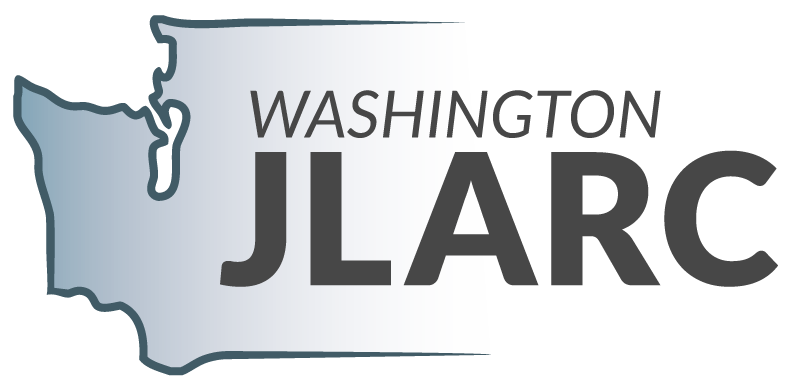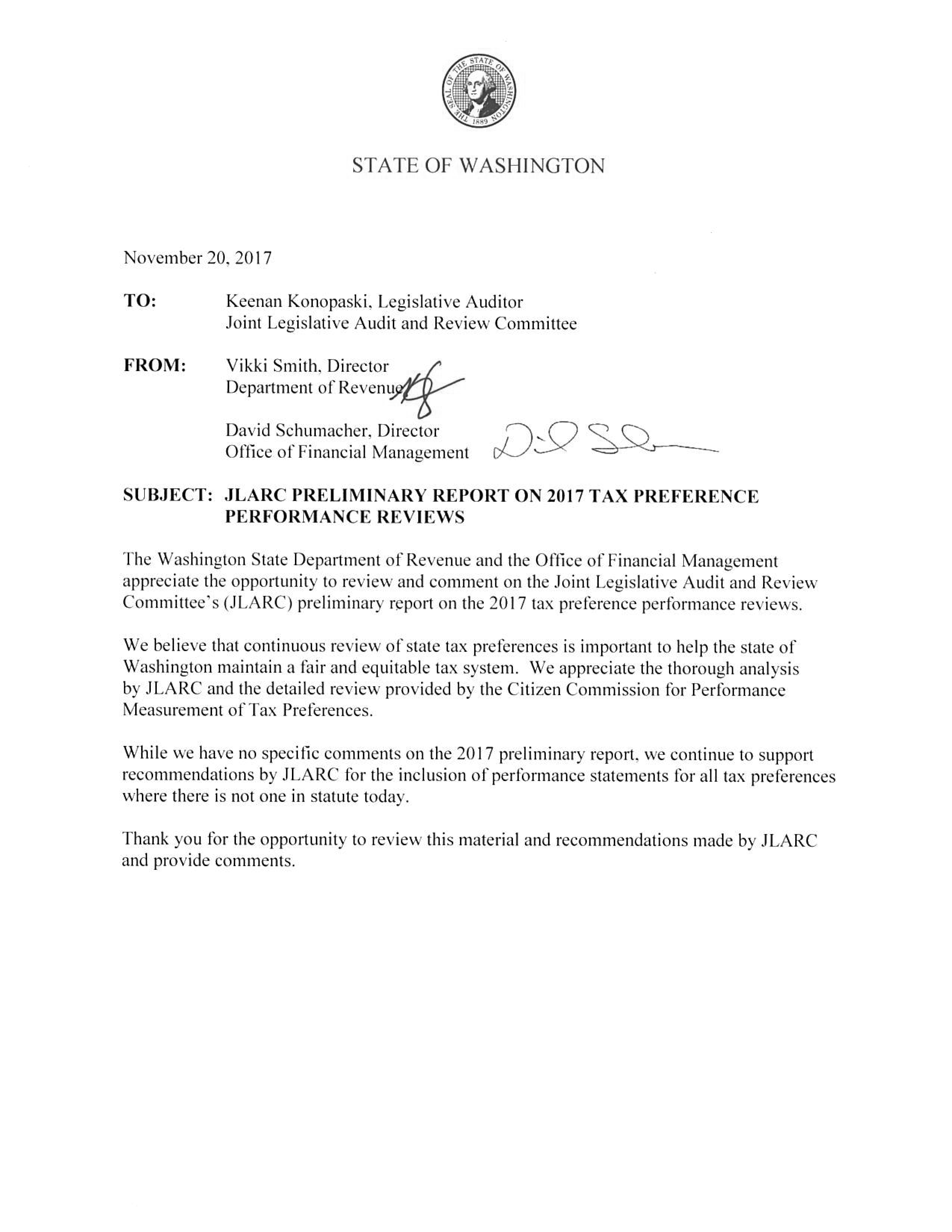 |
JLARC Final Report: 2017 Tax Preference Performance Reviews |
Report 17-07, December 2017
Cogeneration Facilities and Renewable Resources | Public Utility Tax
Click here for One Page Overview
- Summary of this Review
- Details on this Preference
- Recommendations and Agency Response
- How We Do Reviews
- More about this Review
| The Preference Provides | Tax Type | Estimated Biennial Beneficiary Savings |
|---|---|---|
A public utility tax deduction to utilities based on the cost to produce electricity from cogeneration or renewable energy resources. |
Public utility tax |
$0 |
| Public Policy Objective |
|---|
The Legislature stated it wanted to encourage efficient energy use and a reliable supply of energy based on renewable energy resources. |
| Recommendations |
|---|
|
Legislative Auditor’s Recommendation Terminate: The Legislature should add an expiration date to terminate this preference because it is not currently being used and there will be no remaining eligible utilities within a few years. Commissioner Recommendation:The Commission endorses the Legislative Auditor’s recommendation without comment. |
- 1. What is the Preference?
- 2. Other Relevant Background
- 3. History, Objectives, Beneficiaries, Impact
- 4. Applicable Statutes
Public utility tax deduction for the cost of renewable electricity production
Purpose
The Legislature passed this preference with the stated purpose to:
- Encourage efficient energy use.
- Encourage a reliable supply of energy from renewable energy resources.
Public utility tax deduction for the cost of electricity production
The preference offers a deduction to utilities. The deduction is based on the cost to produce electricity from cogeneration or renewable energy resources.
- Cogeneration delivers two forms of energy (electricity and heat) from one fuel source.
- Renewable resources include solar, wind, hydroelectric, and geothermal energy, plus wood, wood wastes, municipal wastes, agricultural products and wastes, and end-use waste heat.
The preference also includes amounts utilities spent to improve the efficiency of consumers’ energy use or reduce their electrical usage.
Preference is time limited, but has no expiration date
The preference was enacted in 1980 and does not have an expiration date. But, there is a time limit:
- Only new facilities and efficiency measures that started construction or installation between June 12, 1980 and January 1, 1990 are eligible.
- Utilities may claim the preference for up to 30 years after a project was placed in operation.
For example, if construction started on a facility in 1989 and it began operations in 1991, the utility could claim the deduction through 2020.
Renewable energy generating equipment qualifies for a different preference
Washington law also provides a 75 percent remittance, or refund, for sales and use taxes paid on machinery and equipment for generating renewable energy. It is currently scheduled to expire in 2020.
Stated public policy objective not currently met because utilities are not using the preference
Legislature stated its public policy objective
The Legislature passed the preference in 1980. In its findings, the Legislature stated that the public policy objective was to encourage “efficient energy use and a reliable supply of energy based upon renewable energy resources.”
The bill enacting the preference also required the Utilities and Transportation Commission to adopt policies encouraging the use of cogeneration, energy efficiency, and renewable energy to meet new demand. The Commission was required to allow a higher rate of return on these projects when construction or installation took place before 1990. As a result, utilities had the opportunity to charge a higher rate to customers.
Preference may have met the objective at one time, but is not currently contributing to it
DOR tax records show that utilities claimed the preference until 2013.
The preference is not currently contributing to the achievement of the time-limited public policy objective because Department of Revenue tax records indicate that no utilities use it. The preference applies only to facilities where construction began before 1990.
Continuing the preference will not contribute to the public policy objective because no utilities are currently using it.
No beneficiaries are claiming the preference
Direct beneficiaries of this tax preference are utilities that started construction or installation on eligible facilities between June 12, 1980 and January 1, 1990, and are within the 30-year window for claiming the preference.
Northwest Power and Conservation Council data indicate there may be eligible utilities. However, DOR tax records show that:
- The number of utilities claiming the preference declined after 1996, when 23 reported the deduction.
- No utilities have claimed the preference since 2013.
Since the preference is unused, it is not currently meeting its objective.
No revenue or economic impacts of the tax preference
JLARC staff identified no current or future beneficiary savings associated with the preference because no utilities are claiming the preference.
No impact from terminating the preference
Eligibility is time limited, so there will soon be no utilities eligible to claim the preference. As a result, terminating the preference would have no negative effect. Further, continuing the preference will not contribute to the public policy objective because utilities are not claiming it.
No states appear to have similar incentives
JLARC staff did not identify any similar tax incentives for utilities based on production costs at cogeneration or renewable energy facilities.
RCW 80.28.024
Legislative finding.
The legislature finds and declares that the potential for meeting future energy needs through conservation measures, including energy conservation loans, energy audits, the use of appropriate tree plantings for energy conservation, and the use of renewable resources, such as solar energy, wind energy, wood, wood waste, municipal waste, agricultural products and wastes, hydroelectric energy, geothermal energy, and end-use waste heat, may not be realized without incentives to public and private energy utilities. The legislature therefore finds and declares that actions and incentives by state government to promote conservation and the use of renewable resources would be of great benefit to the citizens of this state by encouraging efficient energy use and a reliable supply of energy based upon renewable energy resources.
RCW 82.16.055
Deductions relating to energy conservation or production from renewable resources.
(1) In computing tax under this chapter there shall be deducted from the gross income:
(a) An amount equal to the cost of production at the plant for consumption within the state of Washington of:
(i) Electrical energy produced or generated from cogeneration as defined in *RCW 82.35.020; and
(ii) Electrical energy or gas produced or generated from renewable energy resources such as solar energy, wind energy, hydroelectric energy, geothermal energy, wood, wood wastes, municipal wastes, agricultural products and wastes, and end-use waste heat; and
(b) Those amounts expended to improve consumers' efficiency of energy end use or to otherwise reduce the use of electrical energy or gas by the consumer.
(2) This section applies only to new facilities for the production or generation of energy from cogeneration or renewable energy resources or measures to improve the efficiency of energy end use on which construction or installation is begun after June 12, 1980, and before January 1, 1990.
(3) Deductions under subsection (1)(a) of this section shall be allowed for a period not to exceed thirty years after the project is placed in operation.
(4) Measures or projects encouraged under this section shall at the time they are placed in service be reasonably expected to save, produce, or generate energy at a total incremental system cost per unit of energy delivered to end use which is less than or equal to the incremental system cost per unit of energy delivered to end use from similarly available conventional energy resources which utilize nuclear energy or fossil fuels and which the gas or electric utility could acquire to meet energy demand in the same time period.
(5) The department of revenue, after consultation with the utilities and transportation commission in the case of investor-owned utilities and the governing bodies of locally regulated utilities, shall determine the eligibility of individual projects and measures for deductions under this section.
*Reviser's note: RCW 82.35.020 was repealed by 2005 c 443 § 7, effective July 1, 2006.
[ 1980 c 149 § 3.]
- Legislative Auditor Recommendation
- Letter from Commission Chair
- Commissioners’ Recommendation
- Agency Response
Legislative Auditor recommends adding an expiration date to terminate the tax preference in the future
The Legislature should add an expiration date to terminate this preference because it is not currently being used and there will be no remaining eligible utilities within a few years.
Although tax records indicate no utilities are using the preference, data from the Northwest Power and Conservation Council indicate there may be eligible taxpayers not claiming the deduction. Taxpayers may only use the preference for up to thirty years after operations begin, and construction must have begun before 1990.
Legislation required: Yes (preference has no expiration date).
Fiscal impact: Depends on legislative action.

The Commission endorses the Legislative Auditor’s recommendation without comment.
